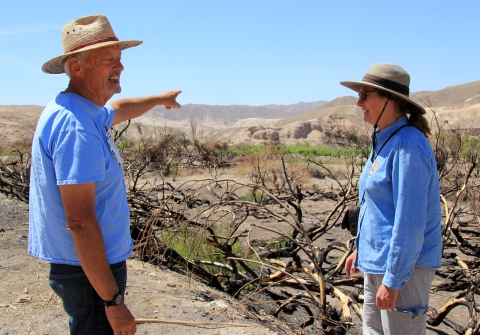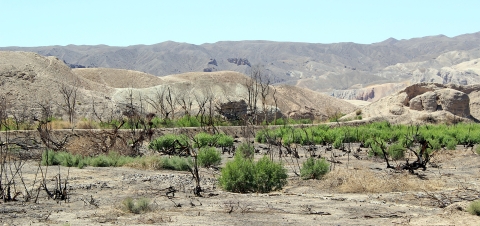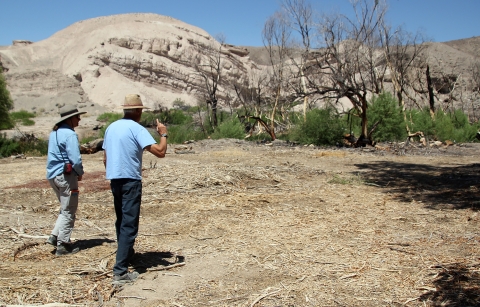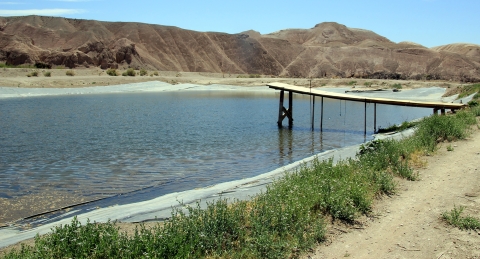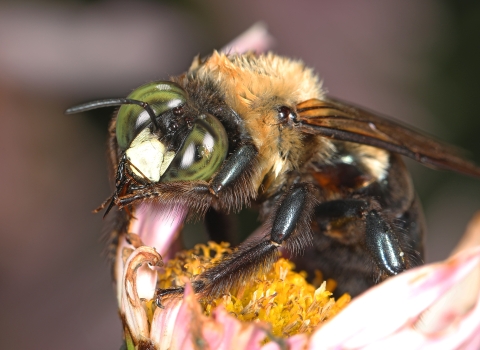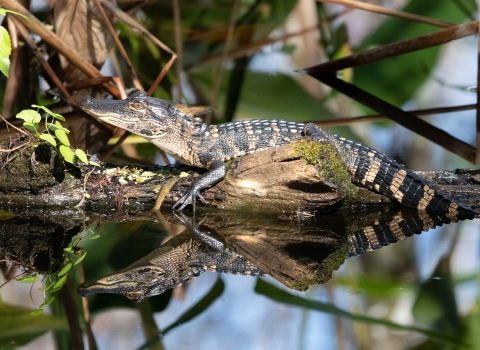Definition of riparian habitat or riparian areas.
Learn more about riparian forest adjacent to his date farm. Manville implements the Partners for Fish and Wildlife Program for the Southern Nevada Fish and Wildlife Office. Credit Dan Balduini/USFWS
By Dan Balduini
Nestled in a slot canyon at the southern doorstep of Death Valley lies the China Ranch Date Farm. Those willing to journey to this oasis near the town of Tecopa, California, will be rewarded with incredible views, rows of date palm trees, an abundance of migratory birds, and a deeper respect for and understanding of conservation.
Inyo County native Brian Brown, the owner and operator of the ranch, knows how difficult it is to scratch out a living in the heart of the Mojave Desert. “There is a long history here of people not being able to support themselves through agriculture and ranching, with failed vegetable, alfalfa, and ranching operations,” Brown said. “Back in 1979, I thought hard about how I could make a living off the land.” His wife Bonnie made more money from several old rows of date trees than he did growing alfalfa. So they decided to give date farming a try.
They learned about date horticulture from workers at the Furnace Creek Ranch, now a part of Death Valley National Park. In 1989, they planted more date trees; focusing on dates that do not do well in commercial agricultural settings. The ranch now produces 15 varieties of dates.
Some success led Brown to open the ranch to the public along with a gift shop and bakery. By 1996, he was able to stop teaching at a local school and become a full-time farmer. Today people travel from as far as New York to buy dates, fronds or date propagules. His date shakes are well known in southern Nevada and California.
China Ranch is so named because it was owned by a Chinese farmer in the 1890s who sold fruit and vegetables to workers mining for borax and gypsum in the area. That era was depicted in the old radio and television series “Death Valley Days,” which was sponsored by companies that included 20 Mule Team Borax.
The ranch was purchased in 1969 by Brown’s father and his aunt. Brown inherited half of the ranch from his father and bought out his cousin for the other half with assistance from The Nature Conservancy and a private donor, who purchased it as a conservation easement conservation easement
A conservation easement is a voluntary legal agreement between a landowner and a government agency or qualified conservation organization that restricts the type and amount of development that may take place on a property in the future. Conservation easements aim to protect habitat for birds, fish and other wildlife by limiting residential, industrial or commercial development. Contracts may prohibit alteration of the natural topography, conversion of native grassland to cropland, drainage of wetland and establishment of game farms. Easement land remains in private ownership.
Learn more about conservation easement . Under the easement agreement, the property was divided into a farming area, a developed area, and a conservation area conservation area
A conservation area is a type of national wildlife refuge that consists primarily or entirely of conservation easements on private lands. These conservation easements support private landowner efforts to protect important habitat for fish and wildlife and major migration corridors while helping to keep agricultural lands in production.
Learn more about conservation area . The conservation area contains 34 acres of riparian forests along Willow Creek. These forests provide homes for the endangered least Bell’s vireo, designated critical habitat for the endangered southwestern willow flycatcher, as well as habitat for many migratory songbirds, and the Amargosa Canyon speckled dace, which is considered a fish of conservation concern.
“The conservation easement agreement is a win-win for me and the surrounding environment,” said Brown. “China Ranch will always remain whole as a working family farm, and as a critical ecological island in the Mojave Desert.”
Brown realized that by partnering with the natural resource agencies and conservation organizations on projects, he could enhance the property and bring in more visitors to the date farm.
With funding from the California River Parkways Grant, the Amargosa Conservancy (a local non-profit group) worked with Brown to establish the Amargosa River Trailhead that connects to hiking trails on the surrounding Bureau of Land Management (BLM) land. Now, many visitors can relax at China Ranch after hiking the Amargosa Canyon along the Amargosa River, which is designated as a wild and scenic river.
The U.S. Fish and Wildlife Service’s Partners for Fish and Wildlife Program (Partners Program) works with private landowners to restore habitat on private land. The program provides funding and technical assistance that the landowners match, commonly with in-kind labor and a commitment to maintain the habitat for a period of time, usually 10 years.
In 2020, with money from the Partners Program, Brown improved the firebreaks adjacent to the orchard. It turned out to be some of the most important work he ever did. In April 2021, a wildfire roared through the canyon. Named the Willow Fire, it burned 23 acres on the ranch, and nine acres on BLM land. The date farm and much of the surrounding forest was spared because of those fuel breaks. Restoration of the burned area is ongoing. With financial assistance from The Nature Conservancy and the Partners Program, along with the help of many volunteers, the forest is growing back. China Ranch, the BLM office in Barstow, California, and the U.S. Fish and Wildlife Service’s Palm Springs Fish and Wildlife Office, are helping ensure a coordinated approach across boundaries.
Brown developed a pond on the property that captures natural spring water he uses to water the orchard. The Partners Program assisted him with adding a liner to the pond that helps conserve water. The pond also acts as a refuge for the Amargosa Canyon speckled dace, which occurs in Willow Creek and the Amargosa Canyon. Maintaining a separate genetic population in the pond provides a measure of security for the fish. Though not currently federally protected, the Center for Biological Diversity filed a petition with the U.S. Fish and Wildlife Service to list the fish under the Endangered Species Act.
U.S. Fish and Wildlife Service Biologist Christiana Manville, who implements the Partners for Fish and Wildlife Program out of the Southern Nevada Fish and Wildlife Office, says she enjoys working with Brown on conservation issues.
“Brian is the kind of landowner that makes my job so rewarding,” Manville said. “He cares deeply about the land and understands that his farm also provides important habitat for wildlife. He is a great source of information on the local environmental and land use history.”
Beyond selling dates and date products, China Ranch has become an ecotourism destination. The ranch offers hiking, birdwatching, a chance to see other animals in the wild, and a history lesson. Once a water stop along the Old Spanish Trail, the location’s history includes explorers, gold miners, horse thieves and farmers.
Find out more about this remarkable place by visiting www.chinaranch.com. For more information about the Partners for Fish and Wildlife Program, visit www.fws.gov/program/partners-fish-and-wildlife.

